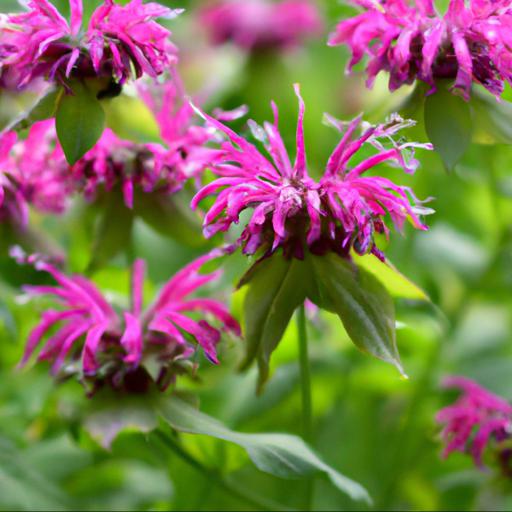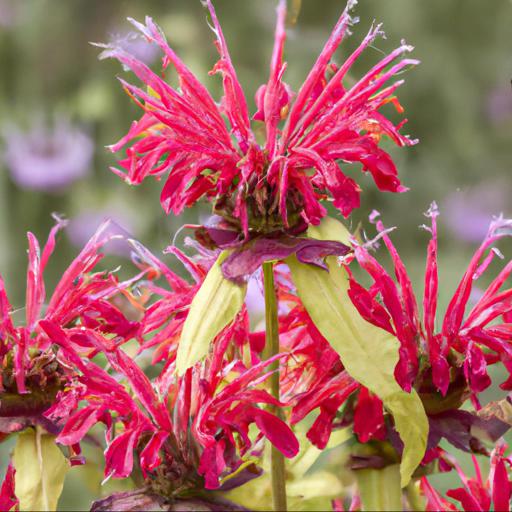Monarda didyma, also known as bee balm, is a beautiful and fragrant flower that has been used for centuries to treat medical ailments. This perennial herb has an interesting history and is native to North America.
Its vibrant red flowers are a favorite of bees and hummingbirds, making it a great addition to any garden. Monarda didyma is packed with medicinal properties and can be used to treat a variety of ailments, from headaches to digestive issues. In this blog, we will explore the history, uses, and benefits of Monarda didyma.
We’ll also discuss how to grow and care for this unique flower, as well as how to make the most of its medicinal properties.
Benefits of growing monarda didyma in your garden

As a UK garden expert, I’m here to remind you of the many benefits of growing Monarda didyma, known as bee balm, in your garden. Monarda didyma comes in an array of eye-catching colours and make a striking addition to any garden border or landscape. With its brilliantly colourful flowers, gorgeous aroma and ability to attract pollinators, this beauty from the mint family is a must-have for every garden.
Monarda didyma has numerous benefits that make it a great choice of plant amongst gardeners and nature lovers alike; starting with its vibrant colour range. From deep red and bright pink to purple and white, its petals create an eye-catching sight that bring instant life and colour to the garden.
In terms of its smell, the blend of tones this flower emits is excellent at attracting pollinators such as butterflies, bees and hummingbirds. For those wishing to add some height to their garden, this is a great option. Monarda didyma can get tall, towering up to almost four feet in height with its lovely spires of fragrant flowers.
At the same time, its spreading habit can help to fill in large empty spaces in the garden. The foliage produces a slightly aromatic scent and an oil that can be used for aromatic and medicinal purposes, depending on the variety of bee balm that you have planted.
In conclusion, it’s clear that growing Monarda didyma brings many benefits to the garden. With its vibrant range of colours, delicious scent and pollinator-attracting qualities, this plant is one great addition to your garden that you won’t regret.
Not only is it a substantial addition to the garden’s design, but it’s great for the environment too, providing nourishment for beneficial insects and animals that come to visit. It’s definitely a must-have!
Tips for planting and caring for monarda didyma

Gardening with Monarda didyma – Expert Tips for a Garden Showstopper If you’re looking for a showstopper for your garden, look no further than Monarda didyma – commonly referred to as ‘Bee balm’. This stunning flowering plant with its bright colors, interesting foliage, and oh-so sweet scent is an absolute must-have for garden aficionados!
In this article, we’ll share some expert tips on how to get the very best from your Monarda didyma. When it comes to planting and caring for Monarda didyma, the key is to ensure the soil is prepared and enriched just right, as this perennial is particular about the type of conditions it prefers. Start off by mixing homemade compost, soil and peat moss together, it should form into a damp, soft bed when mixed together.
Once complete, the next step is to select a spot where the plant will receive a good amount of sun – six hours a day at the very least. After that, simply place your Monarda didyma plant into the ground and lightly pack the soil, making sure your plant is firmly rooted. For maintenance, it’s advisable to increase watering during the summer months, especially during periods of prolonged dry spells.
Once the blooming season begins, it can be helpful to pinch off the spent flowers to promote new growth and increase flowering. As Monarda didyma is a perennial plant, make sure to apply a thick layer of mulch around the base of the plant in order to protect it during the winter season.
By putting in a little extra effort and ensuring Monarda didyma’s growing needs are met, you can soon enjoy the sight of hummingbirds and bees darting between its vibrant petals, as well as its delicate, sweet fragrance snowing your backyard in summertime finesse. So, get to work and start cultivating your very own garden showstopper!
Common pests and diseases of monarda didyma

Monarda didyma, commonly known as bee balm, is a popular herbaceous flowering plant that is commonly found in gardens across the UK. It is a member of the Lamiaceae family and produces beautiful, fragrant flowers of pink, purple, red or white in summer. As well as the pretty blooms, bee balm is a firm favorite with gardeners because it attracts bees and other beneficial pollinators, offering a valuable wildlife habitat.
Unfortunately, it is prone to certain ailments, including a range of pests and diseases. Common pests that attack monarda didyma include aphids, spider mites, flea beetles, and caterpillars.
Aphids are small sap-sucking insects that are usually pale green or yellow in color. They can be found in colonies on the undersides of the leaves.
Spider mites can also cause significant damage to infested plants, leaving them yellow, discolored and stunted. Flea beetles are small, shiny, black beetles which chew small, round holes in the leaves. Caterpillars chew large holes in the foliage, leaving trails of slimy residue as they move around the plant.
Fortunately, most pest issues can be managed with the help of organic controls, such as neem oil or insecticidal soaps. Additionally, aphids, spider mites and caterpillars can all be sprayed with a jet of water to remove them from the plant.
In addition to pests, monarda didyma is also susceptible to a range of fungal diseases, including powdery mildew, rust and stem blight. Powdery mildew can cause the leaves to become covered with a whitish powder, while rust will cause brownish-orange spots and individual lesions. Stem blight can cause the stems to rot and turn black at the base.
To control fungal disease, it’s important to space plants properly and practice good sanitation by removing and destroying affected foliage. Chemical treatments are also available, if necessary.
Creative ways to use monarda didyma in your garden
. Monarda didyma, also known as Bee Balm/Bergamot, is one of the most popular and attractive plants to have in your garden. This perennial herb is easily grown and has fragrant foliage and flowers.
It is a favorite among pollinators and is often incorporated into gardens and landscapes to provide much needed habitat and nutrition for local pollinator species. Bee Balm is a striking addition to the garden with a variety of colors and forms ranging from brilliant red to shades of pink, purple, and white.
When used to its full potential, Bee Balm will give your garden a unique, eye-catching look. In addition to its attractive visual qualities, its fragrant leaves, stems, and flowers make it a perfect addition to any outdoor space. One of the most effective ways to use Bee Balm in your garden is to mass plant it in an ornamental bed.
This will give your yard a vibrant and colorful display that pollinators will flock to. You can also incorporate it into container gardens or window boxes to receive an effortless pop of color.
Plant it near Angelica or Goldenrod for a dramatic statement. Lastly, it also greatly enhances a rock or perennial border and adds a splash of visual interest and fragrance. No matter how you choose to use it, Monarda didyma is sure to be a successful addition to your landscape.
Not only is it visually stunning but its fragrant foliage, nectar-rich blooms, and arrival of pollinators make it an invaluable asset to any outdoor space. So consider adding Bee Balm to your garden to experience its beauty and benefits!
Final Touch
Monarda didyma, commonly known as the bee balm, is a herbaceous perennial native to North America. It is an attractive addition to any garden, with its bright pink, red, or purple flowers and fragrant leaves. It is a favorite of pollinators, and is a great choice for attracting bees, butterflies, and hummingbirds.
Monarda didyma is easy to grow and is tolerant of a wide range of soils and climates. It is also drought tolerant, making it an ideal choice for gardens in drier climates.
FAQ
What are the common names for Monarda didyma?
Common names for Monarda didyma include bee balm, bergamot, and Oswego tea.
What are the characteristics of Monarda didyma?
Monarda didyma is a herbaceous perennial plant native to North America. It is a member of the mint family and has a strong, aromatic scent. It has bright, showy flowers in shades of red, pink, purple, and white. The leaves are lance-shaped and have a toothed margin. It prefers moist, well-drained soils and full sun to partial shade. It is a popular garden plant and is attractive to pollinators.
What is the ideal growing environment for Monarda didyma?
The ideal growing environment for Monarda didyma is full sun, moist, well-drained soil, and a slightly acidic pH. It prefers a slightly acidic soil with a pH of 6.0-7.0. It also prefers a moist environment, but can tolerate some drought.
How often should Monarda didyma be watered?
Monarda didyma should be watered regularly, about once or twice a week, depending on the weather and soil conditions.
What pests and diseases are associated with Monarda didyma?
Common pests and diseases associated with Monarda didyma include powdery mildew, rust, leaf spot, and aphids.
How can Monarda didyma be propagated?
Monarda didyma can be propagated through division, cuttings, or seed.

